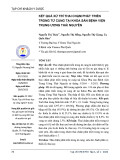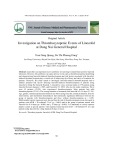
TNU Journal of Science and Technology
230(01): 209 - 216
http://jst.tnu.edu.vn 209 Email: jst@tnu.edu.vn
A STUDY OF MENSTRUAL DISORDERS AND SOME ASSOCIATED FACTORS
IN FEMALE STUDENTS AT HANOI MEDICAL UNIVERSITY
Do Thanh Tung1*, Lo Ba Cuong1, Tran Minh Duc1, Pham Hong Ha1, Nguyen Phuong Tu1,
Nguyen Hai Phuong2
1Hanoi Medical University, 2National Hospital of Obstetrics and Gynecology
ARTICLE INFO
ABSTRACT
Received:
19/8/2024
Menstrual disorders can have a significant impact on women's health
and quality of life, especially among medical university students. Our
study aimed to assess menstrual disorders and some associated factors
in female students at Hanoi Medical University. The descriptive
cross-sectional study was conducted on 312 female students from
August 2023 to January 2024. The results showed over half (55.45%)
of the students reported menstrual irregularities. The most common
issues were oligomenorrhea (46.15%) and menorrhagia (8.33%).
Notably, 95.83% experienced premenstrual symptoms; dysmenorrhea
were the most prevalent during menstruation (93.91%). Menstrual
disorders were significantly associated with BMI, family history of
menstrual disorders, and place of residence before university
admission. Our study’s results provided a better understanding of the
factors associated with menstrual disorders, thus having potential
applications in the prevention and control of the disease.
Revised:
17/10/2024
Published:
18/10/2024
KEYWORDS
Menstrual disorders
Associated factors
Medical students
BMI
Family history
NGHIÊN CỨU TÌNH TRẠNG RỐI LOẠN KINH NGUYỆT VÀ
MỘT SỐ YẾU TỐ LIÊN QUAN Ở SINH VIÊN NỮ TRƯỜNG ĐẠI HỌC Y HÀ NỘI
Đỗ Thanh Tùng1*, Lỗ Bá Cương1, Trần Minh Đức1, Phạm Hồng Hà1, Nguyễn Phương Tú1,
Nguyễn Hải Phương2
1Trường Đại học Y Hà Nội, 2Bệnh viện Phụ sản Trung ương
THÔNG TIN BÀI BÁO
TÓM TẮT
Ngày nhận bài:
19/8/2024
Rối loạn kinh nguyệt ảnh hưởng đáng kể đến sức khỏe và chất lượng
cuộc sống của phụ nữ, đặc biệt là nữ sinh viên trường y. Nghiên cứu
này nhằm đánh giá tình trạng rối loạn kinh nguyệt và một số yếu tố
liên quan ở sinh viên nữ Trường Đại học Y Hà Nội. Nghiên cứu mô
tả cắt ngang được thực hiện trên 312 sinh viên nữ từ tháng 8 năm
2023 đến tháng 1 năm 2024. Kết quả cho thấy hơn một nửa (55,45%)
số sinh viên bị rối loạn kinh nguyệt. Các vấn đề phổ biến nhất là kinh
thưa (46,15%) và rong kinh (8,33%). Đáng chú ý, 95,83% có triệu
chứng tiền kinh nguyệt; đau bụng kinh là triệu chứng phổ biến nhất
trong khi hành kinh (93,91%). Rối loạn kinh nguyệt liên quan có ý
nghĩa thống kê đến BMI, tiền sử gia đình về rối loạn kinh nguyệt và
nơi sống trước khi vào đại học. Kết quả nghiên cứu của chúng tôi
cung cấp hiểu biết tốt hơn về các yếu tố liên quan đến rối loạn kinh
nguyệt, do đó có tiềm năng ứng dụng trong phòng ngừa và kiểm soát
bệnh tật.
Ngày hoàn thiện:
17/10/2024
Ngày đăng:
18/10/2024
TỪ KHÓA
Rối loạn kinh nguyệt
Yếu tố liên quan
Sinh viên y
BMI
Tiền sử gia đình
DOI: https://doi.org/10.34238/tnu-jst.10975
* Corresponding author. Email: tungoct404@gmail.com








































